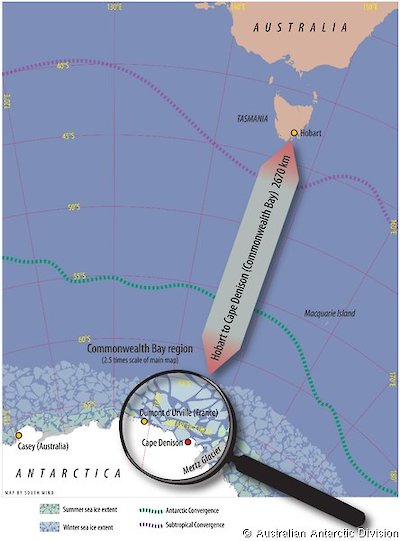Cape Denison: Introduction
In their own words
On either side of the peninsula, now called Cape Denison, the shores of Commonwealth Bay stretched in a great semicircle, bordered everywhere by high ice cliffs, with here and there a patch of black rock showing at the base. Inland a steep slope led upwards to the plateau directly behind the hut, and up this slope sledging parties would ultimately find a way, to explore the new lands, east, west and south.
— Charles Laseron, in South with Mawson: Reminiscences of the Australasian Antarctic Expedition, 1911–1914
Behind me, to the south, the continental shield of ice rose gradually until it met the skyline in an unbroken line of white at an estimated elevation of two-thousand feet … The winter quarters were to be situated at some little distance from the boat harbour at a point where a slight rise in the ground gave it a measure of protection from southerly winders and the immediate area was singularly free from ice. Here was the first locality in our coastwise search where the red and brown bones of the last continent appeared, free of their frozen blanket.
— J K Davis, High Latitude
The wind was the most remarkable feature of the meteorology — or indeed of the locality. It is the outstanding characteristic of Adélie Land. Commonwealth Bay is probably the windiest place on the earth, and certainly it appears to be so as far as records up to the present indicate. For nine months of the year an almost continuous blizzard rages, and for weeks on end one can only crawl about outside the shelter of the hut, unable to see an arms length owing to the blinding drifting snow.
— C T Madigan, AAE Scientific Reports, Series B, Vol IV Meteorology: Tabulated and Reduced Records of the Cape Denison Station, Adelie Land
Adelie Land can only be regarded as an intolerable country in which to live, owing to the never-ceasing winds. Usage and necessity helped one to regard the weather in the best possible light; for the sake of a few hours of calm which might be expected to occasionally intervene between the long spells of the blizzards.
— McLean’s report in The Home of the Blizzard
We dwelt on the fringe of an unspanned continent, where the chill breath of a vast polar wilderness, quickening to the rushing might of eternal blizzards, surged to the northern seas. We had discovered an accursed country. We had found the home of the Blizzard.
— Douglas Mawson, The Home of the Blizzard
It might appear in this narrative there is undue mention of winds and blizzards.
— Charles Laseron, in South with Mawson: Reminiscences of the Australasian Antarctic Expedition, 1911–1914
Temperatures as low as −28 degrees F (60 degrees below freezing-point) were experienced in hurricane winds, which blew at a velocity occasionally exceeding one hundred miles per hour. Still air and low temperatures, or high winds and moderate temperatures, are well enough; but the combination of high winds and low temperatures is difficult to bear.
— Douglas Mawson, The Home of the Blizzard

